Central African Republic
The Central African Republic, also called or the Centrafriquea, in Sango: Ködörösêse tî Bêafrîka, is a developing country in Central Africa, with an estimated population of 4,500,000 inhabitants, covering an area of approximately 623,000 km2 . It is surrounded by Cameroon to the west, Chad to the north-northwest, Sudan to the northeast, South Sudan to the east, the Democratic Republic of the Congo to the southeast and the Republic of Congo at the South West. The country is a member of the African Union, the Economic and Monetary Community of Central Africa, the Community of Sahelo-Saharan States and the Organization of Islamic Cooperation. The country is divided between savannas and equatorial forest (to the south), and essentially experiences a tropical climate. The Central African Republic also has many natural resources, including uranium, gold, diamonds and petroleum. The territory of the Central African Republic corresponds to that of the French colony of Oubangui-Chari, which was part of French Equatorial Africa from 1910 to 1960. After independence, the country was led by various authoritarian regimes, notably that of Jean-Bedel Bokassa, president, then self-proclaimed emperor. The former colonial power continues to play an important role. The first free multi-party elections took place in 1993. They brought Ange-Félix Patassé to power, overthrown in 2003 by François Bozizé. The latter, re-elected in 2005 and 2010, was in turn overthrown in 2013 by Seleka, an alliance of militias led by Michel Am-Nondokro Djotodia, during the second Central African civil war. In 2016, Faustin-Archange Touadéra was elected president of the Republic.
Central African Republic’s history
Prehistory Cut stones dating from at least the 9th millennium BC were found during excavations in the Central African Republic. However, the absence of associated human remains prevents the allocation of these tools to a specific population (pygmies or other indigenous people). Subsequently, the transition from the Paleolithic to the Neolithic in the region was a gradual process without abrupt cultural disruption.
Adamawa-Ubangian and Bantu populations From the third millennium BC, the establishment and vigorous expansion on Central African soil of populations speaking the languages of the Adamaoua-Oubangui group oppose the Bantu expansion which then finds an outlet to the South and the East of the continent. The original geographic nucleus of the Adamaoua-Oubangui language populations would be very close because it is located in the Adamawa massif on the borders of present-day Cameroon, Nigeria, Chad and the Central African Republic. On the other side of the western foothills of Adamaoua (which culminates at 3,400 m at Tchabal Mbabo in the Gotel mountains) was located, on the Cross River, the original nucleus of the Bantu populations. The two groups of populations will experience a simultaneous expansion in the third millennium following the domestication of yams and oil palm. The solid establishment of the populations of Adamawa-Ubangian languages on the territory would be due to their mastery of agricultural crops both in the dry forest area (learned from farmers speaking the languages of the Sudan-Central group) and in the humid forest area, a dual skill that the Bantu did not have at the time. The presence of agriculture in the Central African Republic is proven from the middle of the second millennium BC. The populations of the Adamawa-Ubangian languages complete their establishment throughout the present Central African Republic around the beginning of the 1st millennium BC while the maximum geographic extension of these populations is reached towards the beginning of the Christian era. The inhabitants who had preceded them (pygmies and central Sudanese) on the territory of present-day Central Africa are then either assimilated or marginalized.
A megalithic civilization that lasted until the first century AD. J.-C. develops in the region of Bouar (West). It is the appearance of iron metallurgy which seems to have ended the civilization of megaliths (Tazunu en gbaya). Iron metallurgy spreads from west to east and is accompanied by an expansion of the population which is considered to have reached 6 million inhabitants throughout the Central African territory in the 18th century. The populations would then have lived in relative self-sufficiency because away from the main African trade routes. Between the archaeological beginnings and the period immediately preceding colonization, that is around 1,700 years, data concerning the history of the territory occupied by the Central African Republic are scarce or hardly accessible to the general public. It is likely that, like many peoples established in the equatorial zone, the populations of the region did not feel the need to organize around state structures but rather retained a system of local chiefdoms. In retrospect, and given the supposed demographic expansion of the population (six million inhabitants), one wonders if this system was perhaps not more efficient than many others. The major shortcoming of this very superficial political organization, however, is that it was unable to protect the populations of the Adamawa-Ubangian languages from the trials that were to occur during the contemporary period.
The colonial period (1889-1960) L’Oubangui-Chari in 1910. The first European settlers appeared in 1884. The French set up posts along the rivers, the Belgians along the M’Bomou near the zeriba of Bangassou, Rafaï and Sémio. In 1889 Bangui was built, in 1894, Victor Liotard, governor of Oubangui dependent on the governor of Congo Savorgnan de Brazza, recovered Belgian posts on the right bank of M’Bomou. The French organize Haut-Oubangui in civil and military regions, as well as Chari after the first expedition of Émile Gentil in 1896—97 to Lake Chad; then after the death of Rabah, defeated in Kousseri in 1898 by the French, the colonized territories are divided into administrative districts, the Chari being joined to the Oubangui, base of the future Central African Republic. The territory became a French colony in 1905 under the name of Oubangui-Chari. The territory became an integral part of French Equatorial Africa (AEF) in 1910.
The first years of independence (1960-1965) The country became the Central African Republic on December 1, 1958 and proclaimed its independence on August 13, 1960. Since then, the country has kept French as the official language, used in administrative documents, while Sango, the lingua franca, acts as a unifier of the country, allowing everyone to understand each other, even without advanced school education. The first head of state, Barthélemy Boganda, is considered to be the father of the Central African nation. Member of Parliament in Paris, he was the author of regular fires and requests to maintain all French rights to the people of French Equatorial Africa. A vehement French parliamentarian, he had long advocated the independence of the colonies and had proposed the creation of a single central African state, grouping Gabon, Congo, Cameroon and the Central African Republic. He saw it as the only solution to avoid the break-up of the region into territories that were too small, unviable, and without a role to play on the international scene. He died on March 29, 1959, shortly after his election, in a plane crash, the causes of which have never been clarified.
The Bokassa period and the Central African Empire (1965-1979)
In 1965, during the “New Year’s Eve coup”, Jean-Bedel Bokassa overthrew his cousin David Dacko and took power. On December 4, 1976, he proclaimed himself emperor Bokassa I. He then implemented a very repressive policy throughout the country. In September 1979, “Operation Barracuda”, organized by France, overthrew Bokassa and brought David Dacko back to power. Indeed, for some time Bokassa has been getting closer and closer to Muammar Gaddafi whose policy in Chad is in complete contradiction with French interests.
The after-Bokassa David Dacko succeeds him again briefly. He was expelled from power on September 1, 1981 by General André Kolingba, who established a military regime. André Kolingba will remain in power until 1993, the year when, following the current of democratization launched by the La Baule summit, the first multi-party elections take place and Ange-Félix Patassé is elected president of the Republic. In the late 1990s, Canadian “junior companies”, invested in more than 8,000 mining properties, in more than 100 countries, most of which were still in the planning stage, multiplied contracts with African countries, including the Central African Republic, where they are struggling to find a place, the Colombe Mines, with the main diamondiferous sites.
The Bozizé regime and the civil war (2003-2013) In 2001, an attempted coup led to violent clashes in the capital, Bangui. After a new series of troubles and despite the intervention of the international community (MINURCA), on March 15, 2003, General François Bozizé succeeded, with the help of French soldiers (two fighter planes of the French army flew over Bangui to film the positions of the loyalists on behalf of Bozizé) [ref. necessary] and Chadian militiamen (many of whom will remain with him after his installation in power), a new coup and overthrows President Patasse. General Bozizé then drives out the Congolese rebels, perpetrators of innumerable misdeeds and crimes, especially in and around Bangui. [Ref. necessary] A presidential election took place, after several postponements, on March 13, 2005, under the leadership of an Independent Joint Electoral Commission (CIME), chaired by Jean Willybiro-Sako. We can note as candidates, those of François Bozizé (already head of state), former president André Kolingba, and former vice-president Abel Goumba. The candidacies of several other candidates, including those of Charles Massi of FODEM, former Prime Minister Martin Ziguélé, the former Minister and former mayor of Bangui Olivier Gabirault and Jean-Jacques Démafouth, were refused by the electoral commission before Gabonese mediation and the Libreville agreements. Following these agreements, only the candidacy of former president Ange-Félix Patassé was definitively rejected by the elected committee.
The accession to the presidency of Bozizé is violently disputed and a first Central African civil war ravages the country between 2004 and 2007, until the signing of a peace agreement. However, the rebels denounce the non-keeping of the agreements by President Bozizé, and resume arms at the end of 2012, launching a series of attacks starting the second Central African civil war. On March 24, 2013, the rebels of the Seleka coalition seized Bangui and Bozizé fled. Michel Djotodia proclaims himself president of the Central African Republic. But the numerous abuses committed by the militias of the Seleka, mainly Muslims, bring insecurity in the country, and self-defense militias, the anti-balaka are formed. The conflict leads to a “pre-genocidal” situation according to France and the United States. On December 5, 2013, a UN resolution allows France to send armed troops to the Central African Republic (Operation Sangaris) for the stated purpose of defusing the conflict and protecting civilians. The Phantom State (2013-present) On January 10, 2014, the president of the Central African transition Michel Djotodia and his prime minister Nicolas Tiangaye announced their resignation at an extraordinary summit of the Economic Community of Central African States (ECCAS). On 20 January 2014, the National Transitional Council of the Central African Republic elects Catherine Samba-Panza as head of the transitional state of the Central African Republic In the spring of 2014, three journalists were killed, including the Frenchwoman Camille Lepage, against a background of sanctions of ONU. On July 23, 2014, the belligerents signed a cessation of hostilities agreement in Brazzaville. Despite this agreement, the country is divided into regions controlled by militias, “over which neither the state nor the UN mission has control.”
A presidential election was organized in December 2015 and January 2016. Faustin-Archange Touadéra came second in the first round with 19% of the votes, behind his opponent, Anicet-Georges Dologuélé who came in first with 23.7%. He was finally elected President of the Republic at the end of the second round, with 62.7% of the vote against 37.3% in Anicet-Georges Dologuélé29. This new President of the Republic is launching a process of national reconciliation in order to bring justice to the victims of civil wars, most of them displaced inside and outside the country. To do this, it instructs by decree its Minister Counselor, Regina Konzi Mongot, to develop the National Program for National Reconciliation and Peace, proposed in December 2016, adopted unanimously by international organizations. However, in June 2017, the clashes in Bria, in the center-east of the country, left around a hundred dead. In addition, a committee is also set up to try the main players and compensate the victims. On February 6, 2019, the Central African State signed with the country’s 14 main armed groups a new peace agreement negotiated in January in Khartoum31. Despite this agreement, 80% of the territory remains controlled by armed groups and the massacres of civilian populations continue.
Central African Republic’s politics
The Central African Republic is a presidential republic where the president is both head of state and head of government. Executive power is held by the government while legislative power is shared between the government and parliament. From March 24, 2013, the date of his seizure of power by arms, to January 10, 2014, the date of his resignation, Michel Djotodia fulfills the function of President of the Republic and Nicolas Tiangaye exercises the function of Prime Minister. After their resignation, the interim is provided by Alexandre-Ferdinand N’Guendet, president of the National Transitional Council who then elects Catherine Samba-Panza as Head of the Transitional State of the Central African Republic. She was sworn in on January 23, 2014 and on January 25, she appointed Prime Minister, André Nzapayeké. Following the Brazzaville talks, a cease-fire agreement was signed on July 23, 2014 with the condition that a government of national unity be formed [ref. necessary]. On August 10, 2014, Mahamat Kamoun was appointed Prime Minister of the government of national unity at the head of a government of 30 members where women are highly represented. Faustin-Archange Touadéra became president on March 30, 2016 and its head of government is Simplice Sarandji.
Central African Republic’s demography
The general census of population and housing (RGPH) carried out in 2003 gave a number of 5,391,539 inhabitants: women: 2,707,092 (50.21%); male: 2,684,447 (49.79%); young people under 18: 49.8%; population in rural areas: 3,349,224 (62.12%); population in urban areas: 2,042,315 (37.88%). The previous censuses of 1975 and 1988 had quantified the population respectively at 2,056,000 inhabitants and 2,688,426 inhabitants.Since the beginning of 2007, many non-governmental humanitarian organizations, of all faiths and from all countries, have returned to the Central African Republic, in the wake of the historic actions of the Caritas Internationalis network or of Doctors Without Borders. Projects are currently prioritized on education, agricultural and rural development, support for displaced or migrant populations, access to primary health care, and some microfinance to support local income-generating initiatives.
Central African Republic’s education
The education system in the Central African Republic is modeled on the French model. There are disparities with regard to access to education according to social and regional criteria. As a result, there is a small percentage of women in the school system. The Bangui University built during the Bokassa regime remains the only one that provides public higher education. School has been compulsory since 2008.In September 2013, due to the security situation, 60% of schools in the country were closed.
Central African Republic’s language
The two official languages of the Central African Republic are French and Sango. The country has more than eighty ethnic groups, each speaking different dialects. Sango, the lingua franca, represents a true language of communication, widely shared in the country for trade and exchange. However, it is not spoken by the populations of the North, a predominantly Muslim region. The Central African Republic is a member of the International Organization of the Francophonie as well as of the Parliamentary Assembly of the Francophonie. In addition, the cities of Bangui and M`Baiki are members of the International Association of Francophone Mayors.
-
Central African Republic

CAR Becomes Second Country In The World To Adopt Bitcoin As Legal Currency
The Central African Republic (CAR) has become the second country in the world to adopt Bitcoin as a legal currency,…
Read More » -
Central African Republic
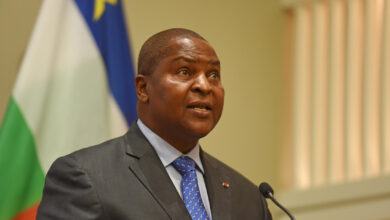
CAR President Faustin-Archange Touadera Declares Unilateral Ceasefire With Rebels
Central African Republic (CAR) President Faustin-Archange Touadera on Friday announced a unilateral cessation with the armed rebel groups, saying he…
Read More » -
Central African Republic
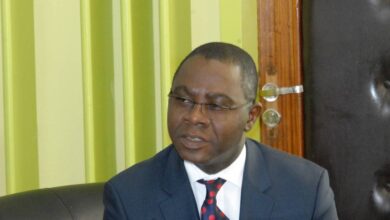
CAR: Former Finance Minister Henri Marie Dondra Becomes New Prime Minister
The Central African Republic’s (CAR) presidency on Friday announced the appointment of former finance minister Henri Marie Dondra as the…
Read More » -
Central African Republic
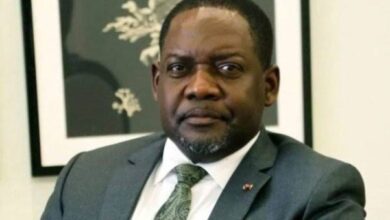
CAR: Prime Minister Firmin Ngrebada Announces Resignation Along With Entire Cabinet
Central African Republic (CAR) Prime Minister Firmin Ngrebada on Thursday announced that he has resigned from his post along with…
Read More » -
Central African Republic
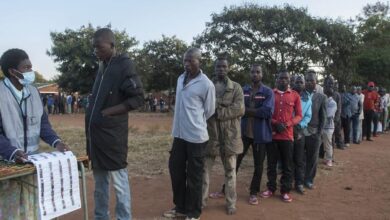
Central African Republic Holds Second Round Of Legislative Polls On Sunday
The people of the Central African Republic (CAR) voted in the second round of parliamentary elections held on Sunday after…
Read More » -
Central African Republic
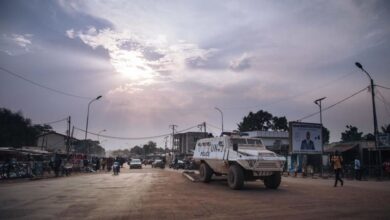
CAR Extends State Of Emergency For Next Six Months As Fight Against Rebels Continues
The Central African Republic (CAR) government on Friday announced it has decided to extend a state of emergency for the…
Read More » -
Central African Republic

ICGLR Appeals For Dialogue To Improve Political & Security Situation In CAR
The International Conference on the Great Lakes Region (ICGLR) made an appeal to the politicians and civil society groups in…
Read More » -
Central African Republic

CAR: Security Forces Killed At Least 44 Rebels Who Surrounded Capital Bangui
The Central African Republic (CAR) government on Monday said the security forces have killed 44 rebel fighters who tried to…
Read More » -
Central African Republic

CAR Declares A State Of Emergency For The Next 15 Days After Armed Attacks
The Central African Republic (CAR) has declared a state of emergency for the next 15 days after armed groups tried…
Read More » -
Central African Republic

CAR Election: Constitutional Court Upholds President Touadera’s Election Win
Central African Republic’s (CAR) Constitutional Court on Monday confirmed President Faustin-Archange Touadera’s re-election in the first round of a presidential…
Read More » -
Central African Republic

CAR Election: President Touadera Wins Re-Election With A Majority Of 53% Of Votes
Central African Republic’s (CAR) Electoral Commission on Monday announced President Faustin-Archange Touadera has been re-elected in the first round of…
Read More » -
Central African Republic
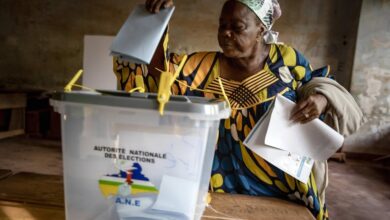
CAR Election: Government Says Sunday’s Polls Were Fully Legitimate & Credible
Central African Republic’s (CAR) government spokesman Ange Maxime Kazagui on Tuesday claimed legislative and presidential elections were fully legitimate and…
Read More » -
Central African Republic

CAR Election: About 800 Polling Stations Remained Closed On Election Day
The electoral commission of Central African Republic (CAR) on Monday said more than 14 percent of polling stations in the…
Read More » -
Central African Republic

CAR Election: Rebel Coalition Announces Ceasefire Ahead Of Sunday Vote
A rebel coalition in the Central African Republic (CAR) has agreed to observe a unilateral ceasefire in the run-up to…
Read More » -
Central African Republic
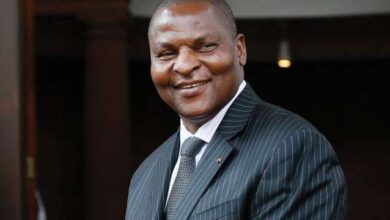
CAR President Appeals People To Defy Threats & Vote In Upcoming Election
The Central African Republic (CAR) President Faustin-Archange Touadera on Monday made an appeal to the people of the country to…
Read More » -
Central African Republic

CAR: Opposition Coalition Calls For Postponement Of December Elections Due To Violence
Central African Republic’s (CAR) main opposition coalition on Sunday called for postponing the upcoming December election due to violence by…
Read More » -
Central African Republic

WHO Says Measles Spread Slowing In Central African Republic Due To Vaccination Campaigns
The World Health Organization (WHO) on Tuesday said two successful vaccination campaigns have helped in curbing a measles outbreak in…
Read More » -
Central African Republic

CAR: President Faustin-Archange Touadera Announces Candidacy For Upcoming Election
Central Africa Republic (CAR) President Faustin-Archange Touadera announced his candidacy for the upcoming presidential election in December on Saturday, reported…
Read More » -
Central Africa
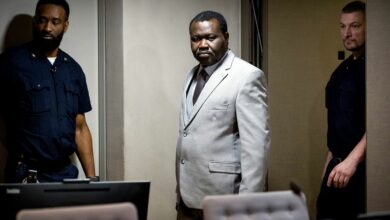
ICC Confirms Central African Republic’s Alleged Militia Leaders To Face War Crimes Trial
The International Criminal Court on Wednesday confirmed the charges brought by prosecutors against two men suspected of war crimes and…
Read More »

